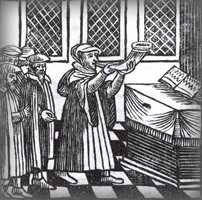 |
“Sounding
the shofar” From Minhagim (Customs) Amsterdam, 1707 |
The Jewish New Year—Rosh Hashanah, ‘head of the year’—was originally called Yom Teruah, ‘the day of sounding of trumpets’; the sounding of the shofar—a ram’s horn which is blown somewhat like a trumpet—is one of this day’s most important observances. The ten days starting with Rosh Hashanah and ending with Yom Kippur are known as the ‘days of awe’ or the ‘days of repentance’. For Jews this is a most auspicious time, a period sanctified for serious introspection and repentence; during the ritual known as taschlich (‘casting off’), breadcrumbs are cast into a river or other body of water as a symbol of the shedding of sin.
It
is said that on Rosh Hashanah God decrees the fate of every individual
for the coming year, hence the wish that one might be “inscribed
for a good year.” During the subsequent days individuals are given
the chance to alter this fate through prayer, repentance and good deeds,
however on Yom Kippur the book of fate is sealed. As a symbol of the wish
for a sweet new year it is customary to eat apples dipped in honey.
No work is permitted on Rosh Hashanah. Much of the day is spent in synagogue,
where a special prayerbook called the machzor (‘cycle’)
is used. A machzor contains not only the basic liturgy, but also many
piyutim, Hebrew liturgical poems. Many of these prayers have special melodies
which are used only on the high holidays, some of which are quite ancient,
having been passed down through the generations.
For more see: Days of awe and atonement.